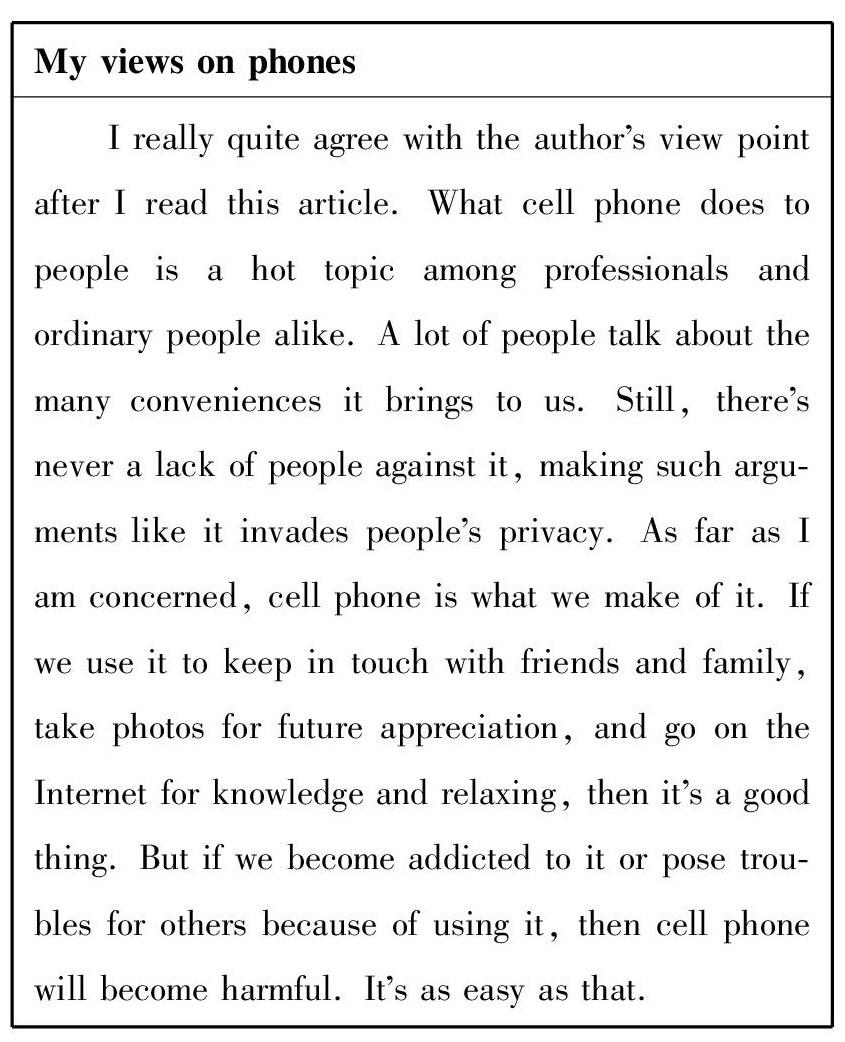报刊阅读策略微探
蒋菊香



最新修订的以核心素养为中心的《普通高中英语课程标准》对高中学生的阅读和写作都提出了较高的要求,教师应根据高中学生的认知特点,培养学生基本语言运用能力。Kmshen(1985)的输入假设理论认为学习者要习得一个新的语言结构,单靠几道练习题,几篇短文远远不够,语言学习必须有足够的输入量。同时他也指出当第二语言习得在自然语言环境下,学习者接触略高于自己现有水平的可理解性(Comprehensive input)的阅读材料,才能自然而然习得语言。按这一理论,适当增加可理解的比学生原有水平难度大的阅读材料是很有必要的。在高中英语教学中,课本知识只提供英语学习的“范本”,如果能根据高中阶段的学生、教材、教法以及教学目的的具体情况,有选择地利用报刊资源,把英语报刊作为语言输入的一种手段,无疑能更好地提高高中生的英语读写能力。
一、报刊阅读的意义
英语报刊作为大众传媒,其通俗化的语言贴近生活,实用性强。学生通过阅读贴近时代和自身生活的各种不同风格的文章,能拓宽眼界,积累关于英美国家文化的背景知识;同时学生经常接触到大量的贴近生活的英语语言,也能扩大词汇量,从而提高英语阅读能力。此外,英文报刊题材多样、内容丰富,教师可以设计学生相互交流的环节,让学生对所读内容进行归纳总结,这种方式也能促进学生的英语口语交际和书面表达能力。总之,报刊阅读无疑对提高学生英语综合运用能力有很大帮助。
二、报刊阅读的策略
合作学习法,是一种旨在促进学生在一种异质小组中互相合作,达到共同学习的目的。具体做法是在教师的指导下,把班级分成合作小组,学生们以小组合作的形式进行学习。每个小组承担学习任务的一部分,然后互相交流信息,学生只有彼此合作,才能圆满完成任务。基于合作学习理论,我们可以利用英语报刊,给学生提供地道的目的语和足够量的语言输入,从而提高学生应用英语的综合能力。
英语报刊的内容多,容量大,仅靠一周一课时远远不够,所以报刊阅读应课外泛读和课内精讀相结合。课前先给学生布置好阅读任务,一篇是指定阅读的文章,另一篇是由学生根据自己兴趣选择报刊文章进行阅读。通常教师指定的文章也是经过挑选的不同题材的文章,以便让学生全面了解英文报刊的特点;由学生自己确定的自选阅读文章,有利于调动他们的学习积极性。
1.课外泛读,课堂检测。首先,不妨采用小组合作法,在课前先组织学生根据自己的兴趣爱好,分成不同的兴趣小组;再根据学生自由组合的兴趣小组布置学生进行报刊阅读任务,在阅读指导中,我们尤其要抓住认知的感觉和记忆环节,让学生对所阅读材料进行记忆整合,在组内提前对所读内容进行讨论、交流;同时指导学生利用各种途径学习,如网络、图书馆对文章所涉及的背景、文化、人物等进行拓展,搜集有关信息。
随后的课堂上,继续以兴趣小组为单位,互相交流阅读内容,发表观点和看法。
案例1 Teens Seniors 2017~2018学年第26期
本期内容涵盖了娱乐、政治、校园、科普等领域,教师提前让学生根据自己的兴趣分好小组,不同小组阅读不同的领域的文章,每个小组有20分钟的展示时间(Group Presentation),展示内容主要包括本小组所选读的报刊内容的摘要或观点阐述,4个小组所选取的报刊内容如下:
学生准备充分,通过小组合作形式进行积极交流,锻炼了搜集信息、自主学习的能力,提高了口语表达能力;学生对阅读内容进行整合而形成的文章的过程,也锻炼了写作能力。
2.课堂精读,形成系统。对英文报刊中价值高的文章,用精读的方式,课堂上在老师的指导下进行阅读。
案例2
《新高考》英语进阶2017年11期第32页,全文如下:
Almost half of the participants in a study who were asked to switch off their phone notifications for a day said it was still influencing their habits two years later so maybe dealing with your phone addiction isnt as difficult as you think.Just a day away from the pings and buzzes can make a differ-ence,say the researchers behind the new study.They also found participants felt less distracted and more productive during the 24 hours
of abstinence.
To begin with,Martin Helot from telecom-munications firm Telefonica in Spain.and Luz Rello of Carnegie MeHon University,wanted to extend their Do Not Disturb challenge across a whole week——but they couldnt find anyone to take part for that length of time.“We just got empty horrified stares,”Helot told Timothy Revell at New Scientist.“And so eventually we backed down to 24 hours.”
Pielot and Rello found that the responses to a day away from alerts varied a lot:for people who didnt check their phones that much anyway,it wasnt such a big deal.But for those whose friends,bosses and co-workers expect prompt replies,the study brought on some extra stress and anxiety.Overall,the group of 30 volunteers reported feeling significantly less-distracted and significantly less-distracted and significantlypro-ductive over the day.
For nine participants,the Do Not Disturb challenge brought on extra feelings of missing out on something,whether a message from a friend or a package delivery alert.At the same time 11 participants reported feeling less stressed and more relaxed having switched their notifications off.
The researchers noted two big factors at play—the potential stress of being interrupted by constant notifications,and the potential stress of missing out on something important and the balance between those two varied from person to person.Participants were still be allowed to look at their phones to see if an alert had come in,and sure enough the amount of phone checking ended up being higher than normal when alerts wereswitched off.
Another downside was that participants felt less-connected to their social groups asa result of the Do Not Disturb challenge.so theres a 10t to take in from the study:it shows how phone notifi-cations interrupt and distractus,but also how they connect us to others andenable us to manage social expectations.
On top of all those findings,the researchers are keen to point out how the day off from phone alerts changed habits in the long term—22 of the volunteers said they planned to modify their phone notification settings as aresult of the Do Not Dis-turb challenge,and after two years 13 of them were still following through with the changes.
Considering most people rarely touch their phones notification settings,thats a high nun-ber.
(1)复习导人。在小组展示的个语言输出的过程中,学生需要灵活处理文章的内容,选择恰当的词语和句子来组织语言,从而达到灵活运用语言的能力。
随后,进行“reading”版面的精读,先以“What if you are forbidden to use?”为话题进行导入,在学生回答之后,引入本篇报刊文章“Blocking Phone Alerts for Just One Day Can Change Your Habits For Years”,通過标题让学生猜测“alters”一词的意思,导入文章。
(2)阅读理解。给学生2分钟浏览文章,找出文章的主题句,看学生对全文大意有多了解。随后5分钟精读文章,要求对找出各段落的主题句,并进行再次分段。同时根据上下文和构词法,猜测生词如notification,distracted,horrified,switch等词义,请学生用英文表达说出相应的生词的意思,教师同时进行相应的补充。
然后,聚焦本期报刊第33页进行文章内容相关的阅读理解检测,学生应独立完成相应题目,然后分小组自由讨论,对于有争议的题目进行组内讨论或教师答疑的方式,最终让学生真正掌握这篇文章所要表达的内容。
(3)拓展任务。拓展任务包括摘录和辩论两个环节,摘录主要目的让学生更理解并记忆文章中的好词好句。教师设计表格让学生进行摘录,学生自由摘录文章出现的优美词句,然后进行组内分享,其形式可以有讨论问题、交流阅读心得等,通过交流能让学生最大程度掌握并理解文章的优美词句。在这过程中如有疑问,教师进行一一解答。这里学生的摘录表格如下:
摘录后进行辩论环节,要求学生对话题“Are you for or against the phone?Why?”进行辩论并发表白己的观点。通过这个环节,学生对文章的理解就上了一个新的层次,并使学生从单向的语言输入上升到双向的语言输出。
(4)归纳总结。归纳总结部分一方面是学生对这节课所获得英语知识的汇总,继续在摘录表格中进行记录,最终形成对这一话题的自我观点,通过这一形式继续锻炼学生的写作和记忆能力。这里摘录学生的观点总结如下:
同时也会进行组内和小组之间轮流交换观点,实现资源共享,最终达到对本篇本章的英语词句的深刻记忆和灵活运用。
英语报刊阅读能否充分发挥其功能,还在于教师积极探索和改进教学方法,一方面自己要经常研究报刊杂志,保持与学生同步;另一方面要引导学生在英语报刊的阅读与写作中不断发现问题、解决问题,进一步增强学生的读写能力,从而达到最终提高英语综合能力的目的。

